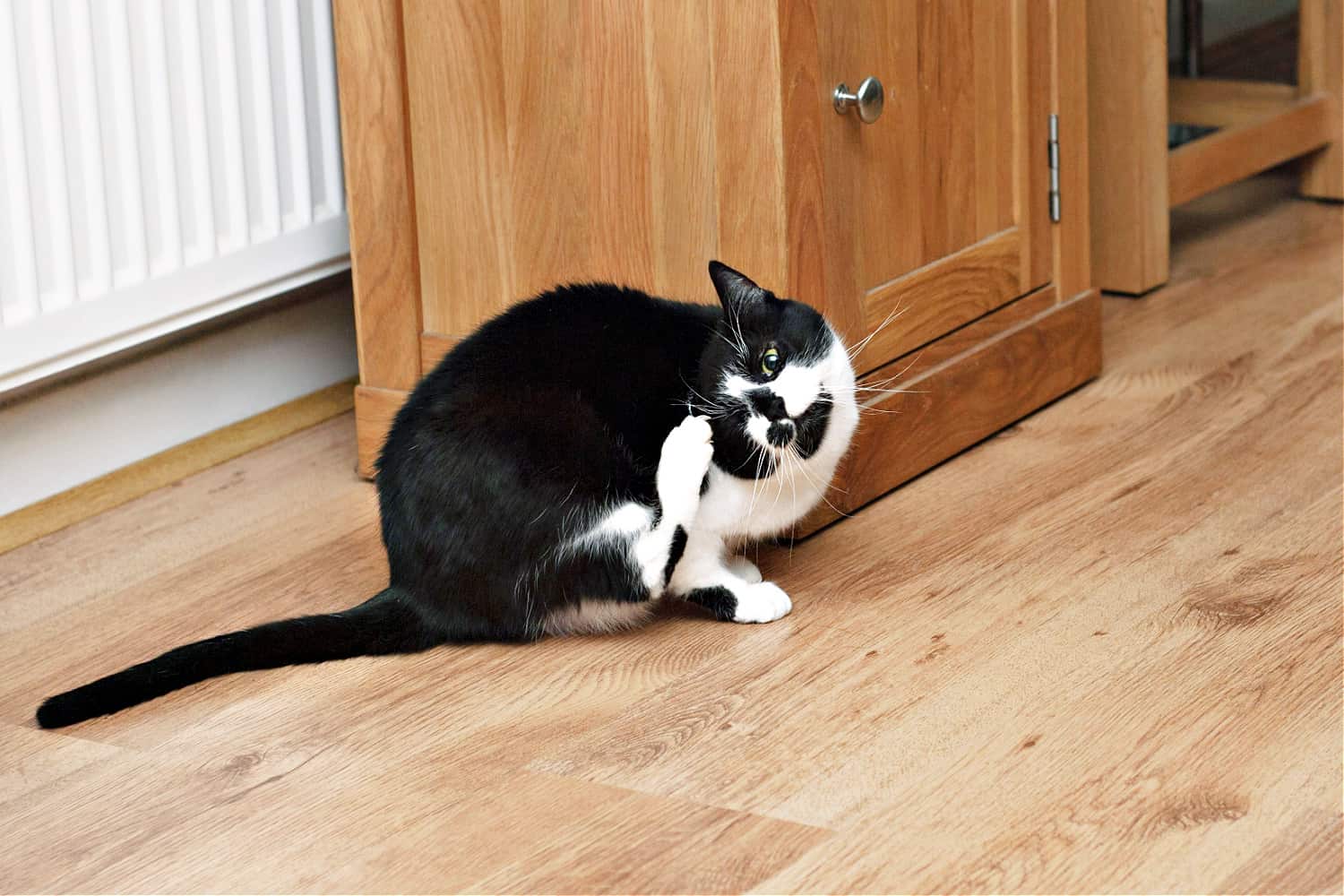Frontline is well-known for getting rid of fleas and ticks. But sometimes, it doesn't work as expected. Is Frontline not working for your cat? You're not alone.
So, what's going wrong? Let's figure out why Frontline might not be doing the job, so we can help our cats.
In this guide, we'll talk about why Frontline, a popular flea treatment, might not always work. We'll look at common problems, like hard-to-beat flea problems, mistakes in using the product, and how time plays a role.
We will also show you how to treat your home, talk to your vet, and ensure the correct product application. Then, talk about other treatments that might work better than Frontline for some cats.
At the end, we'll talk about how to stop fleas from coming back, to help you keep your cat's life comfy and free of fleas.

When Frontline Doesn't Get Rid Of Fleas
You've been using Frontline as you should, but your cat is still scratching, and fleas are still there. There could be a few reasons why Frontline isn't working.
Fleas In Your Home And Yard
One big reason is that your house or yard might still have fleas. These fleas can jump back onto your cat after you treat them. To get rid of fleas, you need to clean your home thoroughly.
Vacuum carpets, rugs, and upholstery, and wash your cat's bedding in hot water. For your yard, consider a pest control service if the infestation is severe.
Treating All Pets In The Household
If you have more than one pet, it's important to treat all of them. Even if only one pet seems to have fleas, the others could be hosts too. Apply Frontline to all pets in your home to make sure you're not missing any hidden sources of fleas.
Remember, getting rid of fleas takes time. Frontline and other treatments don't work right away. Be patient and persistent. Flea control is not a one-time event but a process.
Vet Consultation & Correct Application
It might be time to seek expert counsel and review your application procedure. Start by involving your vet. They can assess your cat's situation, suggest alternatives, and possibly steer you toward a more effective product.
Meanwhile, review your Frontline application technique. Remember, Frontline should reach your cat's skin, not just the fur, and it's best applied between the shoulder blades - a spot out of your cat's easy reach.
Correct Application Of Frontline
Another problem could be how you're using Frontline. If you don't apply it right, it might not work well. Here are the steps for applying Frontline correctly:
- Make sure your cat is calm and comfortable. This will make the process easier for both of you.
- Open the Frontline applicator. Hold it upright and snap the tip away from your face and body.
- Part your cat's fur between the shoulder blades. You want to see the skin underneath.
- Place the applicator tip on the skin and squeeze out the entire contents onto one spot.
- Don't rub it in or bathe your cat for 24 hours after application. Frontline needs time to spread over your cat's body.
Remember, getting rid of fleas takes time. Frontline and other treatments don't work right away. Be patient and persistent. Flea control is not a one-time event but a process.
With expert advice and correct application, you can be back on track in your fight against fleas.
Managing Home Flea Infestations
Controlling fleas is about more than just treating your cat. Your home is also a big part of the battle.
The Flea Life Cycle And Your Home
Understanding the flea life cycle can help you understand why your home is so important. A flea's life cycle has four stages: egg, larva, pupa, and adult.
Fleas lay their eggs on your cat, but these eggs don't stick to your cat's fur. They fall off and end up in your carpets, furniture, and anywhere else your cat spends time. These eggs hatch into larvae, which then form cocoons and become pupae. Inside the cocoon, the pupa transforms into an adult flea, ready to jump onto your cat.
This whole process can take anywhere from a couple of weeks to several months, depending on conditions like temperature and humidity.

How Cleaning Helps Break The Flea Life Cycle
Because of this life cycle, even if you kill all the adult fleas on your cat, new ones can keep emerging from the eggs and pupae in your home. That's why it's so crucial to keep your home clean.
Regular vacuuming can pick up eggs and larvae from your carpets and upholstery. Washing your pet's bedding in hot water can kill fleas in all stages of life. Using a flea spray for your home can kill fleas and prevent eggs from hatching.
When To Call An Exterminator
If your home has a serious flea infestation, you might need professional help. Exterminators have access to powerful treatments and can help make sure you've dealt with fleas in all stages of life.
Remember, the fight against fleas is a battle on multiple fronts: your cat, your other pets, and your home. By understanding the flea life cycle and how to interrupt it, you can take effective action against these persistent pests.
Exploring Alternative Flea Treatments For Cats
If Frontline isn't working for you, don't worry. There are many other flea treatments available that might work better for your cat.
Spot-On Treatments
Apart from Frontline, there are other spot-on treatments on the market. Products like Advantage II and Revolution are popular alternatives.
These treatments work in a similar way to Frontline, by being applied directly to the skin of your cat and spreading throughout their body.
Each product has its own strengths and weaknesses, so you might find that a different spot-on treatment works better for your cat.
See More About Advantage II For Cats Here
Oral Medications
Oral flea treatments are another option. These are pills or chewable tablets that your cat swallows. Some, like Comfortis and Capstar, work by killing adult fleas on your cat quickly.
Others, like Program and Sentinel, prevent flea eggs from hatching but don't kill adult fleas. Some of these medications require a prescription from your vet.
Flea Collars
Flea collars, such as the Seresto collar, can provide long-lasting protection against fleas. The collar releases a pesticide that kills fleas and ticks. Some collars can protect your cat for up to 8 months.
Different cats can respond differently to different treatments. Don't be afraid to try out a few options until you find the one that works best for your cat.
Just remember to always consult your vet before changing your cat's flea treatment. They can help you understand the pros and cons of each option and choose the best one for your cat's specific situation.
See More About This Flea Collar Here

Preventing Flea Re-infestation
Getting rid of fleas on your cat is just the first step. The real challenge lies in keeping them away for good. Here's how you can prevent a flea re-infestation:
Regular Preventative Treatments - Even after the fleas are gone, continue with regular flea treatments. This could be continuing the use of a spot-on treatment like Frontline, or using an oral medication or flea collar.
Monitor Your Cat's Behavior - Keep an eye on your cat's behavior. Excessive scratching, grooming, or visible discomfort can be signs of a new flea infestation. Catching it early can make treatment more effective.
Home Maintenance - Remember, your home environment plays a crucial role in flea control. Continue to vacuum regularly, wash your pet's bedding, and treat areas where your cat spends a lot of time.
If you had a major infestation, you might even consider a regular schedule with a pest control service to treat your home.
Treat All Pets - If you have more than one pet, make sure all of them are receiving flea treatments. Fleas can easily jump from one pet to another, so it's important to treat all pets in the household.
Regular Vet Check-ups - Regular vet check-ups can help catch any potential flea problem early. Your vet can provide advice tailored to your cat's specific needs and circumstances.
Remember, every cat is unique. What works for one cat might not work for another, so it's always important to consult with your vet before changing your cat's flea treatment.
Stay persistent in your efforts to maintain a flea-free environment, and you'll be rewarded with a happier, healthier cat.
You might also like:
Bathing An Adopted Cat: Necessary Or Optional?
4 Things Reddit Users Do to Groom Their Cats [And One They Don’t]
Some elements on this page may have been created by our team using advanced AI to provide you with top-notch cat inspired ideas. Read more about our AI Content Policy.



